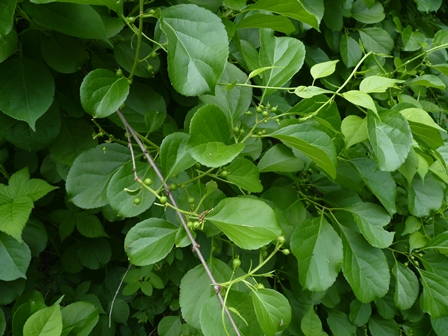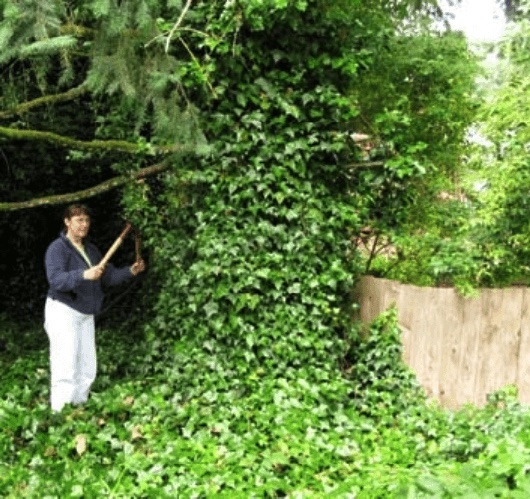We Need to Untwine the Vines
by Carolyn R. Casey, Fairfax Master Gardener

Poison ivy on tree
Some pesky vines throughout the Commonwealth of Virginia pose a serious threat to our environment and our community, snuffing the life out of trees and shrubs. These vines provide greenery throughout the year but will eventually take the life of their host trees or shrubs, and they will spread to others in neighboring yards and properties if not properly managed and controlled.
Travelling down the George Washington Parkway and many other roads, I cannot help but see the vines climbing, engulfing and suffocating trees and shrubs alike. Northern Virginia’s oldest and beloved trees are in danger, and the threat is hidden in plain sight. Yet there are few who recognize it. These vines are invasive and are spread by birds who eat the berries, then nest in trees and shrubs.
Common invasive nonnative and native vines include: English ivy (Hedera helix), Virginia creeper (Parthenocissus quinquefolia), poison ivy (Toxicodendron radicans), porcelain-berry vine (Ampelopsis glandulosa var.brevipedunculata), Japanese honeysuckle (Lonicera japonica), Chinese wisteria (Wisteria sinensis), Japanese wisteria (Wisteria floribunda), kudzu (Pueraria montana), mile-a-minute (Persicaria perfoliate), trumpet creeper (Campsis radicans) and oriental bittersweet (Celastrus orbiculatus).

Oriental bittersweer foliage
According to Bo Arrington, Nashville Tree Conservation Corps board member and arborist with Bartlett Tree Experts, none of these vines are good for trees. When vines get big and spread, they suffocate the host trees and shrubs. Their leaves block air and sunlight from the bark, and the vine’s roots compete with the trees and shrubs for nutrients in the soil below it. The vines have hairs that clasp onto and attach themselves to the bark, which puts more stress on trees and shrubs. These also make it hard to remove the vines, and frequently a crowbar or another tool is needed to pry them off. That is why arborists, like Bo, recommend removing vines as soon as possible. Vines slowly grow over and kill trees if not properly maintained, so paying close attention is essential. The amount of time it will take to do damage depends on the tree and the type of vine.
Invasive native plants can be damaging and costly. According to the United States Department of Agriculture and Natural Resources Conservation Service, only exotic or introduced plants can be called invasive. Invasive-acting native plants are called opportunistic native plants. They take advantage of disturbance to the soil or to existing vegetation and spread quickly and out-compete other plants on the disturbed site. Using this definition, not all opportunistic native plants are bad. In fact, many are great for reclaiming disturbed sites, protecting soil and providing wildlife habitat after a disturbance. But both native and non-native invasive vines can be problematic for homeowners.
Many homeowners grow fruits and vegetables for their families and depend on native pollinators. As our native plants surrender to invasive plants, pollinators that rely on them will vanish. Light cannot reach the foliage of the native wildflowers because it is blocked by the foliage of invasive vines. This is fatal for wildflowers. The disappearance of the wildflowers leads to the disappearance of insects and then birds.

English ivy out of control
Some invasive vines species alter the very structure or function of the ecosystems they invade, so that those ecosystems no longer provide growing conditions suitable for native flora. To restore these areas, it is usually necessary to address the ecosystem changes that have occurred before re-introducing native vegetation. Invasive vines do extremely well at using nutrient rich soils to boost fast and profuse growth. They change the soil chemistry that gives future generations of invasive plants an advantage. Fall decaying stems and leaves release nutrients into the soil creating the precise medium for growing more invasive plants. The elimination of the vines creates an area that is too sunny for forest plants. For renewal to happen, the creation of a native meadow having early successional trees, and a long-term observation and preservation program must be made.
Invasive vines are killing mature trees and shrubs with alarming frequency, robbing them of their ability to capture deadly carbon emissions. As the climate warms, and as summers lengthen, winters shorten and the Mid-Atlantic region becomes increasingly wetter, there are more opportunities for invasive vines to thrive and threaten native trees and shrubs. Even when invasive vines are not killing trees and shrubs, they are weakening them.
“Tree Rescuers” is a community education and outreach program. It makes people aware of non-native invasive vines, which pose a threat to millions of mature trees and shrubs in Northern Virginia. It is a campaign aimed at preserving our area’s mature trees. Tree Rescuers volunteers learn how to identify problematic vines, then walk their neighborhoods spotting trees that need help. The Tree Rescuers do not remove vines but warn landowners by dropping off a brochure explaining the problem and ways to fix it. Tree Rescuers is part of “Plant NOVA Trees,” a five-year campaign by local governments and nonprofit organizations to increase tree cover in Northern Virginia. Native trees are a key part of the solution to many community problems, from extreme weather and air and water quality to the health of birds, wildlife and Chesapeake Bay.
The Invasive Management Area (IMA) Volunteer Program is a community-based project designed to reduce invasive plants on our parklands. IMA is more than just pulling weeds. It is also habitat restoration and a long-term commitment to parks. Invasive plant species are difficult to remove and control, but with the help of IMA volunteers, undesirable non-native invasive plants are removed, and native plants are returned to the habitat. The IMA project began in 2006 with 20 sites. Since then, more than 150 acres have come under IMA management, and there are 65 active IMA sites with over 90 volunteer site leaders. More acres have been treated and restored by contractors and staff.
In neighboring Maryland, there is a group of volunteers known as “Weed Warriors” that are taking to forests, parkland, vacant lots and public rights-of-way to stop these trees and shrubs from choking to death. It trains residents to distinguish invasive vines from native species and empowers them to come to the aid of dying trees by removing non-native vines from any public land in the Takoma Park area. Volunteers are sent out to remove choking vines from trees. They fan across the city and spend three hours at sites on publicly owned land or where property owners have given them permission to work on moving thickets of weeds and vines from vulnerable trees and native plants. They believe that trees are some of the best climate-based solutions we have.
Environmentalists say that it is a remarkably efficient and localized way to address climate change. An experienced hand can remove deadly vines from a tree in as little as five minutes, immediately adding five or 10 years to the tree’s lifespan.
We can diminish invasive vines by learning more about which are opportunistic native vines and invasive nonnative vines. When purchasing plants avoid buying non-native ones. Some nurseries and big box stores still sell them.
Next month, consult this website to learn how to identify and remove nonnative invasive and native opportunistic vines that result in struggling and suffocating trees and shrubs on our properties and in our neighborhoods.
Resources
• Why it’s important to remove vines from your trees, Nashville Tree Conservation Corps
• The Vine That Ate Charlottesville, Ellen Powell, Virginia Department of Forestry
• Millions of Trees At Risk In Northern Virginia? Introducing Tree Rescuers!, Margaret Fisher, Audubon
Society Northern Virginia
• Fighting Climate Change, One Vine-Covered Tree at a Time, Josh Kurtz, Maryland Matters
• Invasive Management Area Program, Fairfax County Government Park Authority